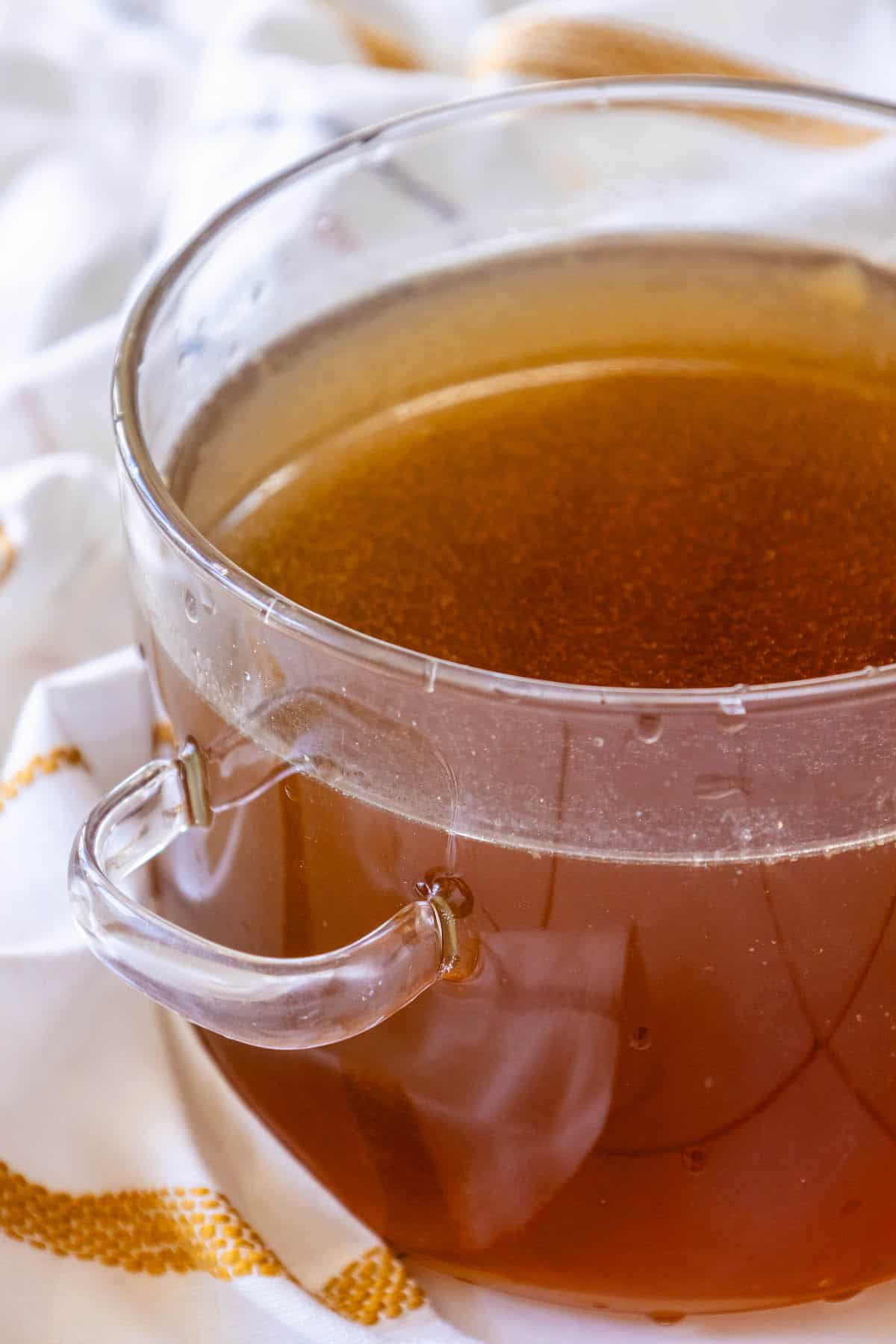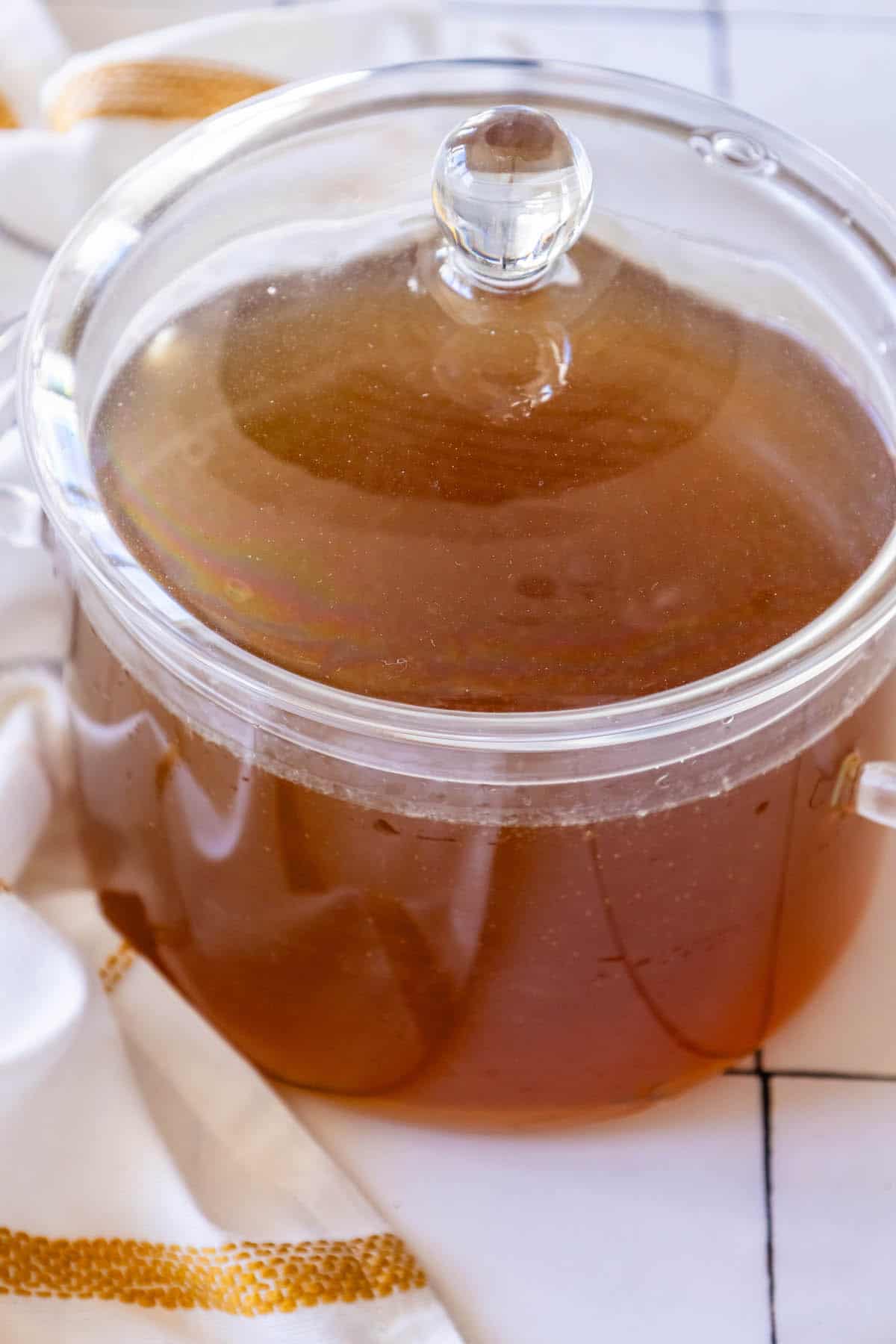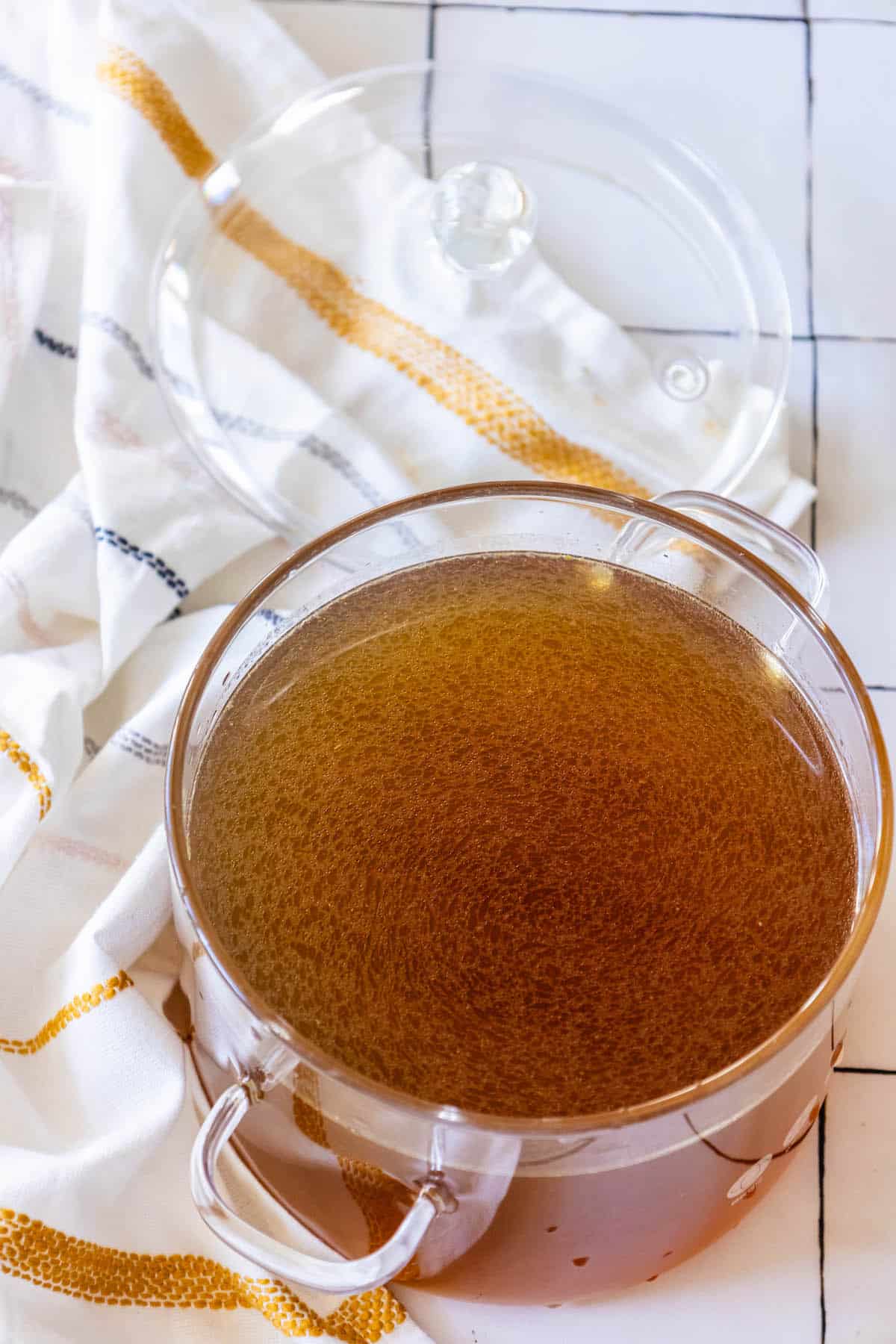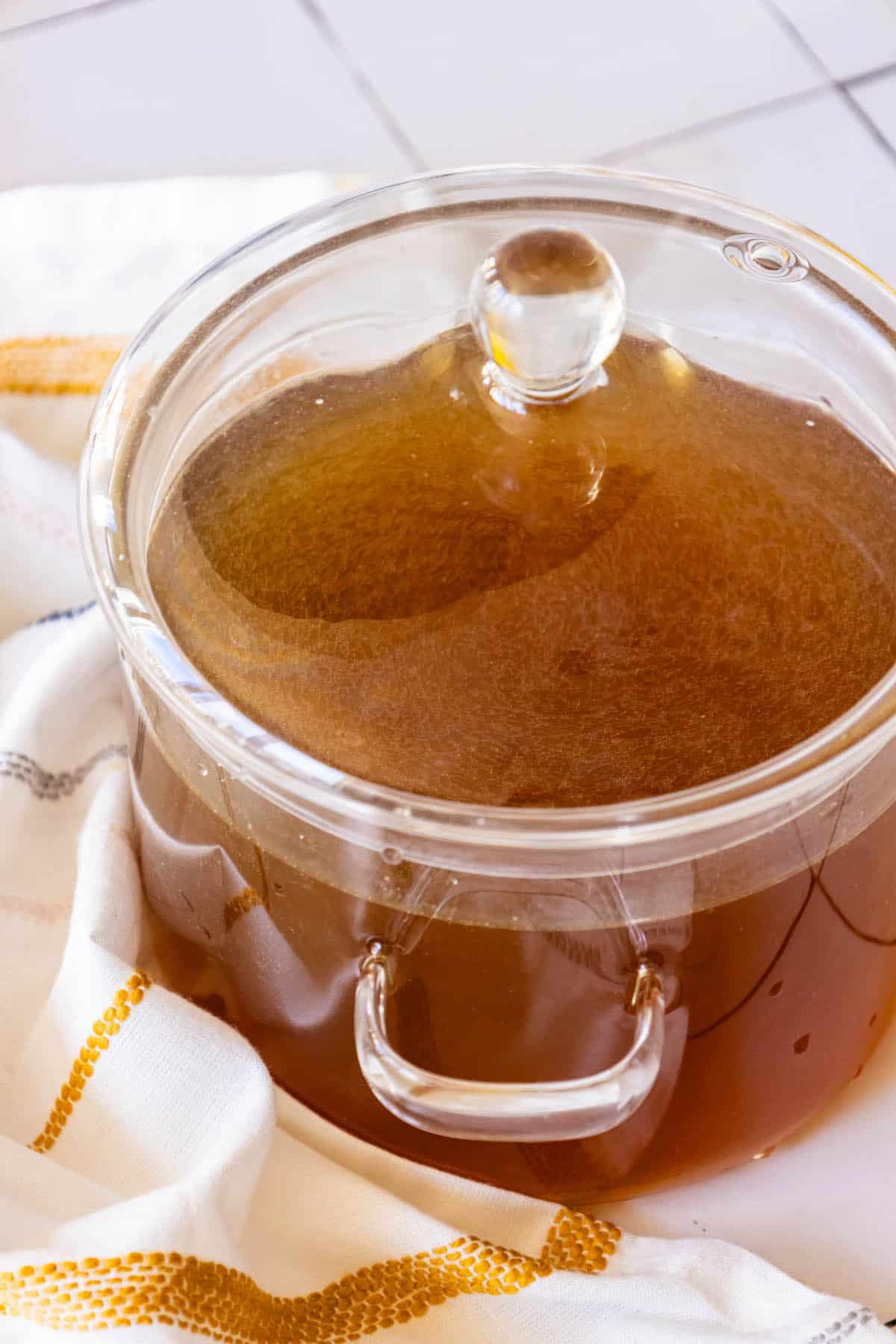This post contains affiliate links. Please read our disclosure policy.
Delicious homemade chicken stock from scratch using rotisserie chicken bones, vegetables, herbs, and spices – perfect for the most flavorful soups, stews, and casseroles!

Don’t want all the extras in a recipe post? We provide a skip to recipe button in the top left corner, as well as a clickable table of contents, just below, to help make this page easier to navigate.
Table of Contents

Chicken Stock from a Rotisserie Chicken
Homemade chicken stock is a fundamental ingredient in many kitchens, prized for its rich flavor, versatility, and the way it elevates the taste of countless dishes. This liquid gold is the result of simmering chicken bones, vegetables, and aromatic herbs and spices in water, coaxing out their flavors and nutrients over time.
The process of making homemade chicken stock is a labor of love that begins with collecting leftover chicken bones, whether from a roasted chicken, rotisserie chicken, or even a combination of bone-in chicken parts. These bones, along with vegetables like onions, carrots, celery, and garlic, are gently simmered in water for hours, allowing the flavors to meld and intensify. The result is a savory, golden elixir that serves as the foundation for countless recipes.
One of the beauties of homemade chicken stock is its adaptability. Depending on the ingredients and seasonings used, it can be tailored to suit a variety of culinary styles and cuisines. Whether you’re preparing a classic chicken noodle soup, a flavorful risotto, a hearty stew, or a velvety sauce, homemade chicken stock provides the essential depth and complexity of flavor that store-bought versions often lack.
Beyond its culinary applications, homemade chicken stock is also cherished for its health benefits. It’s packed with nutrients, including collagen, which can promote joint health and contribute to radiant skin. Plus, it’s a soothing and nourishing elixir that’s often consumed on its own as a comforting drink, especially when feeling under the weather!

How to Make Chicken Stock
- Carcass from a Rotisserie Chicken: The carcass contains leftover bits of meat and bones, providing a rich chicken flavor and body to the stock.
- Onion: Onions add a sweet and savory depth of flavor to the stock, enhancing its overall taste.
- Carrots: Carrots contribute a subtle sweetness and a hint of earthiness to the stock. They also provide a pleasant color to the liquid.
- Celery: Celery imparts a mild, herbal note and adds complexity to the stock’s flavor profile.
- Garlic: Garlic brings a subtle hint of garlic flavor and aroma to the stock, enhancing its savory qualities.
- Bay Leaf: Bay leaves are aromatic and lend a subtle herbal essence to the stock, enhancing its overall bouquet.
- Whole Black Peppercorns: Peppercorns provide a touch of spiciness and a peppery aroma, complementing the other flavors in the stock.
- Water: Water serves as the base for the stock, extracting and carrying the flavors of the other ingredients as it simmers.
Once you’ve gathered your ingredients, we will use the following process:
- Start by removing any remaining meat from the chicken carcass and set it aside for other recipes or to add back to the stock later.
- Place the chicken carcass in a large stockpot.
- Add the chopped onion, carrots, celery, garlic, bay leaf, and black peppercorns to the pot.
- Cover everything with enough water to submerge the ingredients completely. Make sure to leave some room at the top of the pot to prevent boiling over.
- Bring the mixture to a boil over high heat, then reduce the heat to low and let it simmer uncovered for at least 2-3 hours. The longer you simmer, the richer the flavor will be.
- Skim off any foam or impurities that rise to the surface with a spoon during simmering.
- Once the stock has simmered to your satisfaction and has a rich flavor, remove it from heat.
- Strain the stock through a fine-mesh sieve or cheesecloth into a large bowl or another pot to remove the solids. You can discard the solids.
- Allow the chicken stock to cool, then refrigerate it. The fat will rise to the top and solidify, making it easy to skim off and discard.
- Your homemade chicken stock is now ready to use in soups, stews, sauces, or any recipe that calls for chicken broth or stock.

Tips and Tricks for Perfect Chicken Stock
Start with a Good Carcass: Use the leftover carcass from a well-cooked roast chicken or a rotisserie chicken. The more meat and flavorful bits left on the bones, the better the stock will be.
Roast the Bones (Optional): For extra depth of flavor, consider roasting the chicken carcass and vegetables in the oven before making the stock. Place them on a baking sheet and roast at 375°F (190°C) for about 30 minutes or until they’re nicely browned. This step is optional but enhances the overall flavor.
Include Vegetables: Adding aromatics like onions, carrots, celery, and garlic to the stock will contribute depth and complexity to the flavor. Roughly chop these vegetables to release their flavors more effectively.
Use Cold Water: Always start with cold water when making chicken stock. This allows the flavors to slowly release and develop as the water heats up.
Avoid Salt at the Beginning: Refrain from adding salt to the stock in the beginning. You can season the dishes you use the stock in later, and this prevents the stock from becoming overly salty.
Simmer Gently: Bring the stock to a boil, then reduce the heat to a gentle simmer. Simmering too vigorously can make the stock cloudy.
Skim the Foam: During the initial stages of simmering, foam and impurities may rise to the surface. Use a spoon to skim off this foam for a clearer and cleaner stock.
Simmer Slowly: Allow the stock to simmer slowly for at least 2-4 hours. Longer simmering times can intensify the flavor.
Add Herbs and Seasonings: In the last 30 minutes of cooking, you can add herbs like parsley, thyme, bay leaves, and black peppercorns for extra flavor. Adjust the seasonings to taste.
Strain Well: Once the stock is ready, strain it through a fine-mesh sieve or cheesecloth to remove any solids. This will result in a clear and clean broth.
Cool and Store Properly: Allow the stock to cool to room temperature before refrigerating or freezing it. Divide it into smaller portions for easier use and storage.
Remove Fat: After refrigerating the stock, you can easily remove any solidified fat from the surface before using it in recipes.
Freeze in Ice Cube Trays: For convenience, freeze some of the stock in ice cube trays. Once frozen, transfer the cubes to a freezer bag. This allows you to use small portions when needed.
FAQs
Homemade chicken stock is a flavorful liquid made by simmering chicken bones, vegetables, and aromatics in water. It’s typically richer in flavor and nutrients compared to store-bought chicken broth, which is often made with added flavors and preservatives.
Yes, you can make chicken stock with raw chicken bones, but using leftover bones from a roasted or rotisserie chicken will provide a deeper flavor.
Simmer chicken stock for at least 2-4 hours to extract maximum flavor. Longer simmering times can enhance the flavor even more.
Yes, homemade chicken stock can be frozen for later use. Allow it to cool completely, then transfer it to airtight containers or freezer bags. Leave some space at the top for expansion, and it can be stored in the freezer for several months.
Once your chicken stock has cooled to room temperature, you can store it in the refrigerator for up to 3-4 days. Be sure to cover it tightly to prevent any odors from the fridge from seeping in.
It’s recommended to avoid adding salt to the stock during the cooking process. Seasoning can be adjusted when you use the stock in recipes, as different dishes may require varying levels of salt.
Homemade chicken stock is incredibly versatile. It can be used as a base for soups, stews, sauces, risottos, and more. It adds depth and flavor to a wide range of dishes.
While you can use chicken bouillon cubes to make a quick broth, they may not provide the same depth of flavor as homemade chicken stock. Homemade stock is often preferred for its richer taste and higher quality.
Yes, it’s a good practice to skim the foam and impurities that rise to the surface during the initial stages of simmering. This helps create a clearer and cleaner stock.
Onions, carrots, celery, and garlic are commonly used aromatic vegetables in chicken stock. These ingredients add flavor and depth to the stock.

What to Make with Homemade Chicken Stock
Soup Base: Chicken stock serves as the foundation for many soups, including chicken noodle soup, vegetable soup, and creamy tomato soup. You can add vegetables, protein, and seasonings to create a delicious homemade soup.
Risotto: Use chicken stock to cook creamy and flavorful risotto. The stock adds depth to the rice while absorbing the savory flavors of the dish.
Sauces and Gravies: Homemade chicken stock is essential for making sauces and gravies. Whether you’re preparing a classic chicken gravy, mushroom sauce, or pan sauce for meats, chicken stock provides the liquid base and flavor.
Braising: When braising meats or vegetables, chicken stock can be used to add moisture and flavor to the dish. It’s commonly used in dishes like braised chicken, pot roast, and braised greens.
Rice and Pasta: Instead of using plain water, cook rice, couscous, or pasta in chicken stock to infuse them with added flavor.
Stuffing: For a flavorful stuffing or dressing for poultry, use chicken stock as the liquid component. It enhances the taste and moistness of the stuffing.
Mashed Potatoes: Add a splash of chicken stock to mashed potatoes for extra creaminess and flavor. It’s a great alternative to milk or cream.
Poaching: Poaching chicken or other proteins in chicken stock adds flavor and keeps the meat tender and moist.
Freezing: Homemade chicken stock can be frozen in ice cube trays or larger portions for future use. This allows you to have stock readily available for recipes.
Cooking Grains: When cooking grains like quinoa or farro, substitute some or all of the cooking liquid with chicken stock to enhance the flavor of the grains.
Vegetable Steaming: Steam vegetables with chicken stock instead of plain water for a delicious and aromatic side dish.
Marinades: Create flavorful marinades for meats and poultry by incorporating chicken stock along with herbs and spices.
Reducing Sauces: Simmer chicken stock to reduce and concentrate its flavor, then use it to drizzle over meats or vegetables as a finishing sauce.
Try these soups:

If you love this easy recipe please click the stars below to give it a five star rating and leave a comment! Pease also help me share on Instagram, Facebook, and Pinterest!
Follow on Instagram
Click here to view the web story for this recipe!

CONNECT WITH SWEET C’S!
Be sure to follow me on social media and get in on all the fun!
Only have 30 minutes to get dinner on the table? Sign up for my 30 minute dinner plans direct to your inbox!
Find and shop my favorite products in my Amazon storefront here!

Homemade Chicken Stock
Equipment
Ingredients
- 1 carcass from a rotisserie chicken
- 1 onion roughly chopped
- 2 carrots roughly chopped
- 2 celery stalks roughly chopped
- 2 cloves garlic smashed
- 1 bay leaf
- 1 teaspoon whole black peppercorns
- 12 cups Water
Instructions
- Start by removing any remaining meat from the chicken carcass and set it aside for other recipes or to add back to the stock later.
- Place the chicken carcass in a large stockpot.
- Add the chopped onion, carrots, celery, garlic, bay leaf, and black peppercorns to the pot.
- Cover everything with enough water to submerge the ingredients completely. Make sure to leave some room at the top of the pot to prevent boiling over.
- Bring the mixture to a boil over high heat, then reduce the heat to low and let it simmer uncovered for at least 2-3 hours. The longer you simmer, the richer the flavor will be.
- Skim off any foam or impurities that rise to the surface with a spoon during simmering.
- Once the stock has simmered to your satisfaction and has a rich flavor, remove it from heat.
- Strain the stock through a fine-mesh sieve or cheesecloth into a large bowl or another pot to remove the solids. You can discard the solids.
- Allow the chicken stock to cool, then refrigerate it. The fat will rise to the top and solidify, making it easy to skim off and discard.
- Your homemade chicken stock is now ready to use in soups, stews, sauces, or any recipe that calls for chicken broth or stock.












